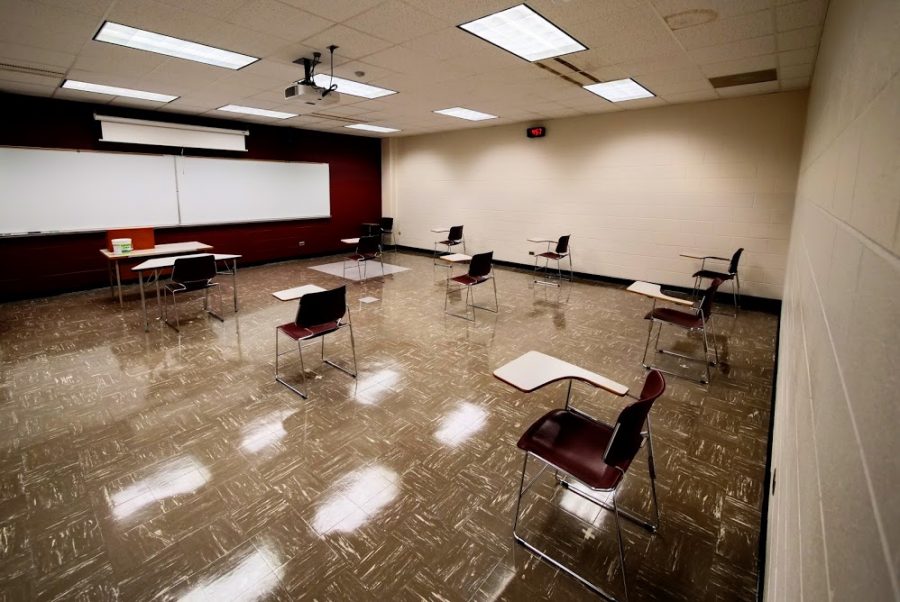Professors adapt to an online classroom
Empty classroom in Dusable
September 11, 2020
DeKALB — As the semester begins, professors are faced with a landscape unlike previous semesters. With online learning accounting for many classes, teachers like Natalie Santiago, English instructor, find themselves managing classes behind a screen.
“[Online learning] is my natural environment,” Santiago said. Santiago said she is very accustomed to online learning, having extensive experience with digital spaces. Santiago studies virtual reality and heralds its potential for learning.
Santiago sits down with students virtually after every major assignment, before students turn in their work. During this half an hour conference, Santiago goes over their work with them. She said her goal is to help students learn and her emphasis has shifted away from grades.
“My whole structure of grading is different,” Santiago said. “I’m not just taking your paper and grading it, at the end we are working on it together to make it a great paper.”
Santiago said having the flexibility to do closer coaching and work with students one on one has always been her dream.
Ben Stone, administrator and instructor for foundations, basic level art classes, is currently doing a staggered, in-person approach, he said. He has been conducting presentations, lectures and critiques online.
“Everything is slower because I only can meet with students half of the time,” Stone said. “I have exercises for the off-day students to do but it so far doesn’t equate to being in class. It is a work in progress.”
While an entirely online format is working for Santiago, at times it can still be taxing.
A typical day for Santiago begins with a lot of preparation and troubleshooting technologically, she said. On average, 5-10 minutes of class time is spent waiting for everyone to log in and get ready to go.
In the case that someone doesn’t log in to class, Santiago said she creates materials to support her students. This ensures students have a chance to stay on schedule, in case of an illness or other extenuating circumstance.
“We need to make hybrid classes out of necessity, we need to make sure we are creating material for students who can’t sit up or are in the ICU,” Santiago said.
Saintiago said she sees a necessity for more training modules for professors to create effective online classes, for all students.
“I foresee our instructional design department creating more materials to help students integrate into online courses,” Santiago said. “I’m sure more than anything that we will have to go to remote learning further into the semester.”
The format of live streaming classes is very practical for some but not for professors like Stone.
“I could live stream I suppose but I haven’t had time or training to figure out how the machines work,” Stone said.
It isn’t practical to expect students to be able to do remotely what they would do in class, Stone said.
“The biggest challenge for me is that my classes tend to feed off of group dynamic and energy,” Stone said. “This is compromised by having several full remote learners and only being able to engage with students one day per week.”
Stone said he wishes we could have figured out how to offer online only sections of classes to accommodate students who need it without compromising the classes that want to meet in-person. Stone said online art classes are hard to keep track of, especially if students aren’t engaged.
“I have huge concerns about limitations,” Stone said. “To the point where I have basically accepted that the overall output of the students and amount of curriculum covered will be diminished.”
If his classes adjust and do well Stone said he has no problem pushing for the full course load.
Santiago said one of her rules for online class is that cameras aren’t mandatory. She said she made this rule for a few reasons: what is camera ready? What if you don’t want to put on makeup? More importantly what if you don’t feel safe letting people into your home?
“The most important thing is to not automatically assume that a student is being difficult,” Santiago said.
Being cooped up in your dorm or apartment can be lonely.
“I know, see and have read a lot of narratives from students about being lonely, so I find myself reaching out more and making those one on one connections more meaningful,” Santiago said.
Santiago said there is a need for teachers and students to create a healthy work life balance. It is important to remember students cannot sit behind a computer screen 24/7, personal time is important.
Santiago said she has played with the usage of VR in her classes previously and this semester she has tried something new. Santiago opened up a Minecraft server As a way to help students and herself relax after class.
“I asked my students if they would be interested in going on field trips with me on minecraft,” Santiago said. “The reaction was overwhelming.”
Santiago said she has been able to help build the community of NIU in a virtual space, something she never had dreamed she would be able to facilitate.
Santiago said she believes thinking critically, something students learn in higher education, is crucial during this time as COVID-19 prevails and elections draw closer. In the world we live in, information is disseminated so quickly that oftentimes we take it for face value. Santiago tries to cultivate these skills in her students, she said.
“We are getting a lot of misinformation about what is occurring, a lot of opinion, some substantiated on science, some not,” Santiago said.“I think education is more important than ever to decipher information from misinformation.”







